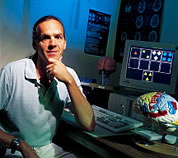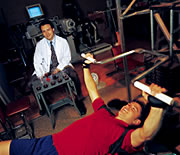 |
|||||||||||||||||
|
|
|
||||||||||||||||||||
Watershed databases Researchers in UNT’s Center for Spatial Analysis and Mapping are creating a watershed atlas that will benefit the people of the Metroplex. Bruce Hunter, director of the center, is coordinating efforts to create a set of databases that integrates information from federal, state and local agencies into one common format. It will provide a comprehensive picture of water quality and quantity for Lakes Lewisville, Ray Roberts and Grapevine. Valuable information about land use over time, oil and gas wells, landfills and hazardous waste sites, storm water run-off and urban growth will be provided in the atlas.
Teaming up for less turnover Having self-managed work teams, or SMWTs, in nursing homes could increase employee morale, leading to less staff turnover and better work performance and care for the elderly residents, says Dale Yeatts, chair of the Department of Sociology. Yeatts compared two different SMWTs in a midsized nursing home. Each team consisted of three certified nurse’s aides. One of the teams was judged by the nursing home administrator and director of nursing as performing at a particularly high level, based on the high level of care that residents were receiving. The other team was judged to be performing at a particularly low level. Yeatts says members of the high-performing team were making decisions about resident care based on their own experiences in working with the residents, as well as on feedback from their supervisor. In the low-performing team, however, the supervising registered nurse was making most of the decisions for the team without consulting team members. Members of the high-performing team had more job satisfaction than those in the low-performing team, Yeatts says.
Sensing metallic impurities M.R. Chyan, associate professor of chemistry, and his research group have developed an ultra-sensitive chemical sensor that can detect metallic impurities as low as the parts-per-trillion level in a whole range of semiconductor processing chemicals. A U.S. patent was recently granted for Chyan’s invention. The silicon-based sensor can have immediate applications in non-stop, online monitoring of wet-chemical baths used in integrated circuit production to prevent losses due to unpredictable contamination. In a study funded by Eastman Kodak Co., the sensor has also been successfully applied to detect traces of silver ions and solve environmental toxicology issues.
Research like clockwork Teenagers and young adults tend to be the most alert and have their best work performances in the afternoon, since their changes in body temperature, hormones and other functions related to circadian rhythms — those daily metabolic, glandular and sleep cycles — contribute to morning sleepiness, says Craig Neumann, assistant professor of psychology. Senior citizens, however, are most alert and have peak performances in the morning, he says. Neumann says understanding the “time-of-day” effect on performances caused by circadian rhythms could be particularly helpful in the treatment of patients with schizophrenia, who tend to have attention deficits with and without medication and who have cognitive defects that cannot be fully explained by their other symptoms. He recently received a $60,000 Young Investigator Award from the National Alliance for Research on Schizophrenia and Depression to conduct time-of-day tests on 50 schizophrenia patients at the Dallas Veterans Affairs Hospital. The research, which focuses on both visual and verbal memory, may result in therapists scheduling therapy for schizophrenia patients during the time of day they perform the best and offering therapy that is more visual than verbal, or vice versa, Neumann says.
Avoiding back alleyways According to a UNT real estate study, prices have shrunk for homes with rear-entry alleyways because of increased crime and headaches. Randall S. Guttery, associate professor of real estate, looked at home sales for 1,672 houses in Denton —some with rear-entry alleyways and others without — from July 1989 to December 1995. The sample included real estate agents’ comments about the sales. He found that due to news of abductions, assaults and robberies of families living in rear alleyway homes, buyers have steadily grown leery. Homes with rear alleyways sold for 5-1/2 percent less than homes without alleyways. According to the research, other contributing factors to this decrease in value are that back alleys take up more of the homeowner’s land, and they typically are not cleaned.
Training and alcohol Weight
training and intoxication don’t mix, says Perry Koziris, assistant
professor of kinesiology. Koziris (left) is conducting research
to determine to what degree intoxication interferes with the expected
improvements of weight training. The delayed effect of intoxication
after a workout decreases muscular endurance, he says, and drinkers
who place high demands on the muscular system in the weight room
should have some concern.
|
|||||||||||||||||||||


